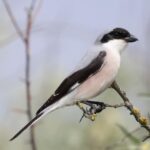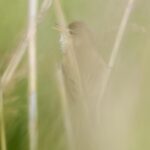Day 2 of a 5 day Autumn Tour today. With few new migrants appearing on the coast yesterday, we decided to head inland to try for something different. After heavy rain overnight, it had pretty much cleared through by the morning, though was still cloudy and a bit damp at first. It brightened up nicely during the day, but was still cool in the blustery west wind.
We drove down to the Wensum Valley first. There had been an Osprey here for some days previously, stopping off on its way south to Africa, and we thought it might be a nice way to start the day today. It has been roaming up and down the river, visiting various fishing lakes. Unfortunately there was no sign of it at its favourite site, or any of its usual haunts. A Common Buzzard sat in the tree overlooking the lakes. Behind us, a Kestrel perched in the top of a hawthorn eyeing us curiously.
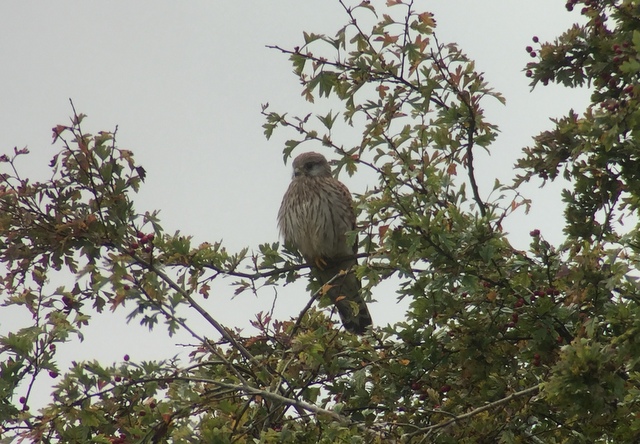 Kestrel – not the Osprey we had hoped to see this morning
Kestrel – not the Osprey we had hoped to see this morning
Still, there were lots of other birds to see here. A Kingfisher zipped back and forth across the lake in front of us. A Grey Wagtail flew over – its very sharp call and, once we then saw it, its bounding flight and very long tail gave it away. A short while later, two Grey Wagtails flew back the other way, right over our heads. There were Siskin here as well – part of the huge influx we have seen in recent weeks. A party of twelve flew in calling and landed in the ash tree right in front of us, dropping down to an alder by the lakes, before flying off again.
Three Stock Doves perched up on the wires. We got them in the scope and had a good look at them, noting the differences from Woodpigeon – the smaller size, lack of a white neck patch and the glossy green there instead, the black spots in the wings. A flock of Golden Plover circled up distantly above the fields beyond. A few lingering Swallows and House Martins flew over.
There was no shortage of Egyptian Geese here. When we arrived, two were in the Osprey’s favourite dead tree, and they stayed there pretty much throughout. Another very noisy party of eight flew in along the river. It was lovely down by the lakes this morning, but it gradually became clear that there had been no sign of the Osprey all morning. We decided to head on inland.
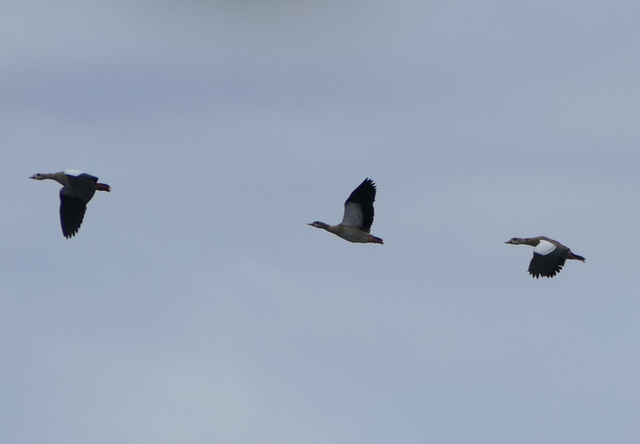 Egyptian Geese – flashing their white wing panels as they flew over
Egyptian Geese – flashing their white wing panels as they flew over
From there, we made our way down into the Brecks. The region is well known for the Stone Curlews which breed here and early autumn is a good time to look for large post-breeding flocks which gather in favoured fields at this time of year. We tried one of the best sites for them but unfortunately there was lots of disturbance today, people working in the fields and lots of tractors driving back and forth. We drove around the area to see if we could find them at any other sites, but there was no sign. We did see lots of other farmland birds – big flocks of corvids around the pig fields, coveys of both Grey Partridge and Red-legged Partridge, both flushed by tractors in the fields, flocks of finches and lots of Pied Wagtails.
With the morning getting on, we decided to head further into the Brecks to Lynford Arboretum to try to add some woodland birds to the list. We walked round the top part of the arboretum before lunch. There were lots of birds, but they were hard to see at times in the tops of the trees. It was rather windy and they were keeping to cover today. Coal Tits outnumbered the rest, with little groups feeding in the fir trees, plus Blue and Great Tits. We also saw several Treecreepers, Goldcrests and a couple of Nuthatches.
After lunch, we walked further into the arboretum, down to the lake. There was a Marsh Tit calling as we reached the bridge, but it disappeared into the trees as we walked up. We tried the woodland walk to see if we could find it again, but as we got back to the bridge it was there again, calling. It was particularly windy by the lake and all the birds were proving hard to see. We walked back up through the arboretum again, seeing much the same as we had earlier. We had to get ourselves back up to the coast to finish, but with the report of a Barred Warbler at Kelling and “showing well”, we decided to head that way earlier than planned to try to see it.
The walk along the lane was fairly quiet today – obviously lots of people had been up and down there already. A few Chaffinches were in the hedges. There were still several butterflies out in the sunshine – Speckled Woods and Red Admirals. We had seen a single Southern Hawker among the trees in the car park at Lynford Arboretum over lunch, but most of the dragonflies out today were Common Darters and Migrant Hawkers. While we were walking down the lane at Kelling a single Migrant Hawker landed on the brambles & nettles along the path, giving us a great opportunity to admire it up close.
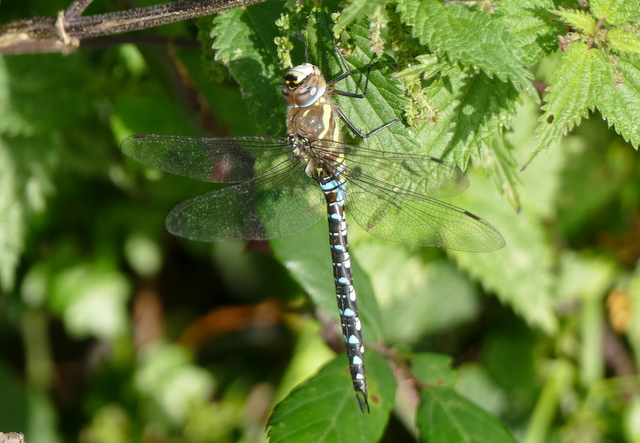 Migrant Hawker – enjoying the sun along the lane at Kelling
Migrant Hawker – enjoying the sun along the lane at Kelling
Out on the water meadow, we could see the regular pair of Egyptian Geese and a smattering of duck – several Teal and three Shoveler, the latter with their heads down constantly in the water, feeding. A lone Curlew was probing in the grass on the edge. A Little Egret was fishing along the north side and a single Grey Heron sat preening in the sunshine in the reeds along the drainage channel on the Quags.
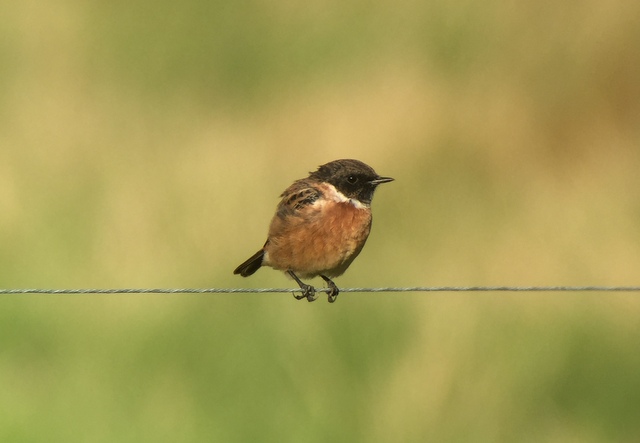 Stonechat – one of the males down at the water meadow
Stonechat – one of the males down at the water meadow
The Barred Warbler had been seen along the hedge between the path and the water meadow, but there had been no further sign of it for a couple of hours by the time we got there. With all the disturbance up and down the lane, it had presumably hidden itself in cover. A party of Stonechat were feeding around the Quags – at least four, two males and two females. They were very active, flying back and forth between vantage points, dropping down to the ground after prey or flycatching up into the air. It was hard to keep up with them. There were also lots of Linnet and Goldfinch around the Quags.
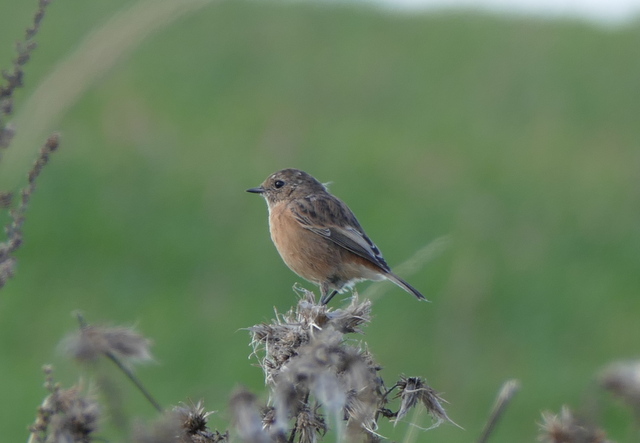 Stonechat – a female perched on the dead thistle head along the lane
Stonechat – a female perched on the dead thistle head along the lane
It was lovely down by the water meadow in the afternoon sunshine, so we stood for a while just in case the main target might show itself again. Lines of gulls were making their way west overhead, presumably heading off to roost, and a few Black-headed Gulls dropped in to bathe. Finally we were out of time and had to make our way back. A Great Spotted Woodpecker perched in the top of one of the fir trees back by the main road, calling, as we left.
